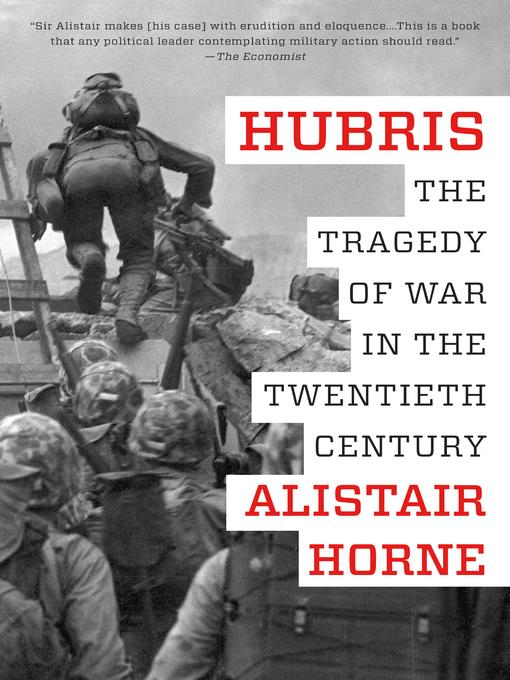
Hubris
The Tragedy of War in the Twentieth Century
کتاب های مرتبط
- اطلاعات
- نقد و بررسی
- دیدگاه کاربران
نقد و بررسی

August 24, 2015
In this well written, deeply researched, and persuasively argued book, Horne (A Savage War of Peace), the venerable British military historian, looks at six critical battles of the 20th century, focusing on what he argues is a constant that links all of them: the hubristic arrogance exhibited by those on the losing end. In military history, the word hubris is most often used to explain one of the primary flaws of American Vietnam War policymakers, but Horne looks across the 50 years that preceded that engagement. He begins in East Asia, examining first the 1905 Battle of Tsushima during the Russo-Japanese War, then moving forward to the obscure, 1939 Battle of Nomonhan— a pre-WWII “border incident” fought by the U.S.S.R. and Japan. Horne then heads to the western U.S.S.R. to address Hitler’s disastrous 1941 attack on Moscow during WWII, before going back to the Pacific to cover the 1942 Battle of Midway. He closes the work with Gen. Douglas MacArthur’s reckless move into North Korea in 1950 and the debacle that ended France’s nine-year war in Indochina at the 1954 Battle of Dien Bien Phu. Horne convincingly argues that “infection by hubris” is alive and well today, and he rounds out the work by discussing ways that 21st-century leaders can work to avoid it.

September 15, 2015
Prolific historian Horne (Kissinger: 1973, the Crucial Year) draws upon decades of research to review six battles that arguably altered the course of the 20th century. Omitting World War I as a product of pride, Horne focuses on the Battle of Tsushima (1905) in the Russo-Japanese War; the World War II battles of Khalkhin Gol (1939), Moscow (1941-42), and Midway (1942); and the battles of Korea Strait (1950) and Dien Bien Phu (1954), addressed together. The military tactics and psychology of commanders are detailed as Horne studies the Japanese side of conflicts--three sections consider Japan and four address conflicts in Asia. The underreported 1939 Soviet defeat at Khalkhin Gol, which led Russia to turn their attention to the Philippines and Hawaii, may be unknown to most readers. These battles were characterized by arrogance and often the result of a sense of racial superiority. Although focusing on the first half of the 20th century, Horne also references Napoleon Bonaparte's invasion of Russia in 1812 and Germany's of Russia in 1941. Character sketches enhance the work, introducing Soviet spy Richard Sorge and "American Caesar" Douglas MacArthur. VERDICT Students of military tactics and general readers will take pleasure in the new insights into these selected battles expressed by this knowledgeable and accessible writer. [See Prepub Alert, 3/23/15.]--Frederick J. Augustyn Jr., Lib. of Congress, Washington, DC
Copyright 2015 Library Journal, LLC Used with permission.

September 1, 2015
After more than 50 years of writing about military matters, veteran historian Horne (Kissinger: 1973, The Crucial Year, 2009, etc.) reflects on "the common features of warfare that stood out over the ages."Concluding that the main common feature is hubris (which the Greeks defined as "the worst sin a leader, or a nation, could commit"), the author makes a convincing, if not original, case by recounting several campaigns from the first half of the 20th century. More than half the book concerns Japan, whose dazzling victory in the 1904-1905 Russo-Japanese War began with a sneak attack and ended with the annihilation of the Russian fleet. Horne emphasizes the characteristics of the land campaign, a brutal, Pyrrhic victory by poorly equipped but extremely aggressive Japanese forces. No one-the United States included-learned from this. Unhinged by hubris, Japan continued to nibble at Russia until 1939, when Stalin sent large forces that inflicted a crushing defeat in the undeservedly obscure battle of Nomonhan, persuading Japan to turn its attention to Hawaii, the Pacific, and South Asia-an unwise decision. More hubris ("victory disease") following Pearl Harbor drove it to send a fleet to disaster at Midway. Using Hitler as an example of hubris is a no-brainer, but Horne delivers an admirable account of the 1941 defense of Moscow, the largest battle in history and the true turning point in the war. He concludes with the Korean War, where Gen. Douglas MacArthur, who nearly epitomizes hubris, delivered a masterful performance, and the 1954 French debacle at Dien Bien Phu. The bibliography is invaluable because Horne seems to have read every popular book on these wars. There is little original research, and he rocks no historical boats, but he has lived long and writes well. A conventional but thoughtful illustration of the stupidity of war.
COPYRIGHT(2015) Kirkus Reviews, ALL RIGHTS RESERVED.

























دیدگاه کاربران